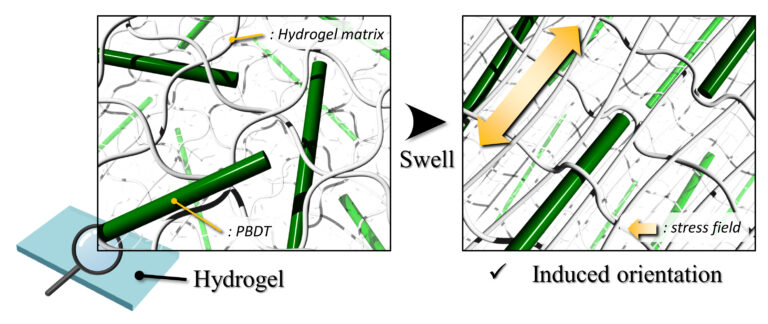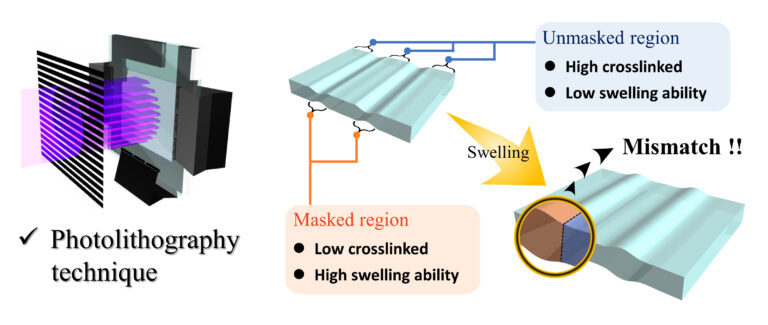Superstructure formation of rigid macromolecules
In this study, as a model system, we use poly(2,2-disulfonyl-4,4-benzidine terephthalamide) (PBDT), a polyanion that is a rigid macromolecule, and chemically crosslinked poly(N-[3-(N,N-dimethylamino)propyl] acrylamide methyl chloride quaternary) (PDMAPAA-Q), a polycation network, as the hydrogel. Inside the synthesized gel, as shown in Fig. 1, the rod-like macromolecules PBDT are embedded inside the hydrogel network. When this composite hydrogel is immersed in water, a transient internal stress field is developed. The embedded PBDT molecules are aligned to directions of stress fields to induce orientation structure. This phenomenon was demonstrated in 2012.

This orientation structure can be confirmed by birefringence which is observed by polarized optical microscope. [Fig.2] It is considered that this lattice-like ordered pattern is induced by the internal stress field originated from swelling mismatch between the surface layer and the inner layer of the gel, since the surface layer swells faster than the inner layer. Why PBDT molecules form such an ordered structure is currently under consideration.

Macroscopic and complicated controlling of superstructures
In 2014, we report a novel strategy to develop hydrogels with macro-scale superstructures from rigid fiber-forming molecules by playing with programmed internal stress. 2) When a soft hydrogel has a swelling mismatching in different regions, an internal stress develops. The internal stress can direct orientation of rigid fiber-forming molecules. In this work, we applied photolithographic technology to induce programmed swelling mismatching in the positively charged hydrogel. [Fig.3]

Considering a slab of hydrogel with alternative stripes of different swelling, the large swelling region experiences a compression from the less swelling region. Oppositely, the less swelling region experiences an extension from the large swelling region. If rigid rod-like molecules are embedded in the hydrogel matrix, they intend to orient along the tensile direction while they orient perpendicular to the compressive direction. Moreover, hydrogels with more complex superstructures could be developed by designing different masks to control the swelling mismatching. [Fig.4]

Stability of superstructures
The swelling of the hydrogel in pure water removes the paired small counter-ions of the oppositely charged polyelectrolytes from the gel matrix (dialysis effect), and therefore, the orientation of PBDT directed by internal stress in the hydrogel was “memorized” by polyion complex formation. As the polymer matrix is in excess of its mass than that the PBDT, a large ionic osmotic pressure still exists to swell the gel substantially. Moreover, the superstructures were preserved even after applying double network technique (inducing the second network of polyacrylamide (PAAm)). The obtained double network gel was much tougher than its single network, sustaining large tensile deformation. Accompanying with the deformation, the superstructure deformed reversibly without rupture. [Fig.5]
Future outlook
In future, we will apply this idea to rigid biomolecules with relatively low molecular weight at high concentration for creation of specific functions. For example, by controlling the orientation of rigid collagen molecules in tough double network hydrogels, we are able to develop hydrogels with anisotropic mechanical properties like cartilages. In addition to this, during tissue growth, different growth rate will build internal stress which may also play a role in directing the orientation of these structural biomacromolecules. This work should give insight in understanding the structure formations of these biomacromolecules in living cells and soft tissues.
References
- Arifuzzzaman, Md., Wu, Z. L., Kurokawa, T., Kakugo, A. & Gong, J. P. “Swelling-induced Long-range Ordered Structure Formation in Polyelectrolyte Hydrogel”. Soft Matter 8, 8060-8066 (2012).
- Riku Takahashi, Zi Liang Wu, Md. Arifuzzaman, Takayuki Nonoyama, Tasuku Nakajima, Takayuki Kurokawa & Jian Ping Gong, “Control Superstructure of Rigid Polyelectrolytes in Oppositely Charged Hydrogels via Programmed Internal Stress”, Nature Communication, 5, 4490 (2014).

